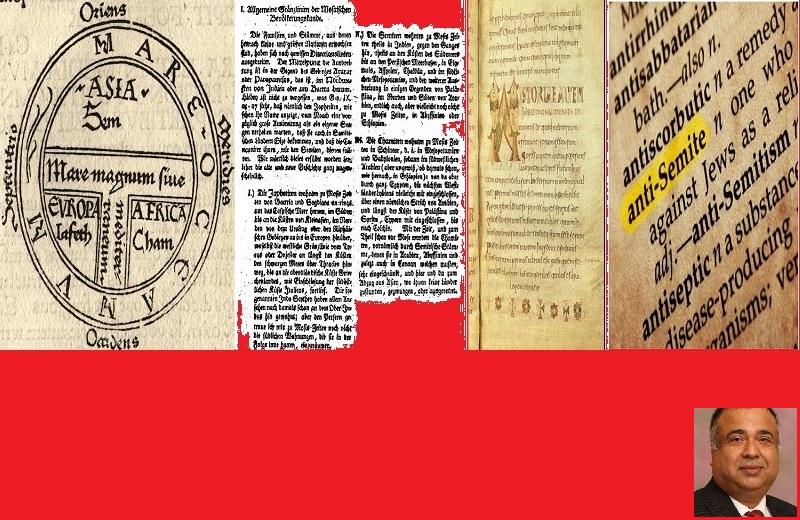Anti-Semitism: An Etymological Quandary
Logic dictates that anti-Semitism ought not to be reserved for Jews exclusively, but that it must include both Arabs and Jews since they are both Semites.
 by Jilani Warsi
by Jilani Warsi
Webster, a reputable name in lexicography, defines Anti-Semitism as hostility toward or discrimination against Jews as a religious, ethnic, or racial group (“anti-Semitism”). Being consistent with its definition of anti-Semitism, Webster delineates the meaning of Semitism as policy or predisposition favorable to Jews. Following this definition, it follows logic then that any policy, statement, or action condescending and disrespectful toward Jews be considered anti-Semitic. Etymologically, the use of the term Anti-Semitism in political and public discourse with the intention of deploring misrepresentations and mistruths defaming and damaging Jewish people’s reputation would be consistent if the meaning of Semite only included Jews. However, Webster defines Semite as a member of any of a number of peoples of ancient southwestern Asia including the Akkadians, Phoenicians, Hebrews, and Arabs, indicating that these four ethnic groups are subsumed under the term (“Semite). Discarding the Akkadians and Phoenicians, since it is difficult to locate their descendants today, it is reasonable to assume that any reference to the Semites would include both Arabs and Jews. For some reason, this is not the case, and anti-Semitism refers to a hostile attempt to denigrate Jews as an ethnic groupin populist discourse, academic, business, and political contexts, posing an etymological puzzle to linguistically-inclined minds. Logic dictates that anti-Semitism ought not to be reserved for Jews exclusively, but that it must include both Arabs and Jews since they are both Semites.
It is worth examining the historical context which gave rise to the coinage of the term. According to Zimmermann, it was the German supremacist Wilfred Marr who inventedthe term ‘anti-Semitism’ to initiate anti-Jewish campaigns in central Europe in 1879 (11). He could have used “Judenhaas”, which means “hatred against Jews”, but he chose to use the term to entice the Germans to despise the Jews living in Germany and elsewhere in Central Europe. In labelling the rabid hatred for the Jewish people, Marr purposely reduced the traditional function of lexical semantics to exclude the Arabs from the term. Britannica rightly points out that the term has been misused consistently since Marr coined it:
"Although the term now has wide currency, it is a misnomer, since it implies a discrimination against all Semites. Arabs and other peoples are also Semites,
and yet they are not the targets of anti-Semitism as it is usually understood.
The term is especially inappropriate as a label for the anti-Jewish prejudices,
statements, or actions of Arabs or other Semites. Nazi anti-Semitism, which
culminated in the Holocaust, had a racist dimension in that it targeted Jews
because of their supposed biological characteristics—even those who had
themselves converted to other religions or whose parents were converts. This
variety of anti-Jewish racism dates only to the emergence of so-called “scientific
racism” in the 19th century and is different in nature from earlier anti-Jewish
prejudices.” (Encyclopedia Britannica)"
As stated previously, since Marr misused the term “anti-Semitism,” its semantic validity remains unquestioned, casting doubt on Marr’s intellectual capacity and his inaccurate knowledge of the Semites. It is the moral obligation of the intellectual to speak truth to the power and not let personal biases and prejudices obfuscate the reality. Said, himself an audacious opponent of injustice and atrocities against a marginalized people, defines an intellectual as follows:
"The central fact for me is, I think, that the intellectual is an individual endowed
with a faculty for representing, embodying, articulating a message, a view, an
attitude, philosophy or opinion, to, as well as for, a public. And this role has an
edge to it, and cannot be played without a sense of being someone whose place it
is publicly to raise embarrassing questions, to confront orthodoxy and dogma
(rather than to produce them), to be someone who cannot easily be co-opted by governments or corporations, and whose raison d’etre is to represent all those people and issues that are routinely forgotten or swept under the rug. The intellectual does so on the
basis of universal principles: that all human beings are entitled to expect decent
standards of behavior concerning freedom and justice from worldly
powers or nations, and that deliberate or inadvertent violations of these standards
need to be testified and fought against courageously (11)."
And that is why it is crucially important to examine the continued misuse of “anti-Semitism” by intellectuals around the world. As mentioned previously, a closer look at the meaning of the word Semitic bolsters the position that the term anti-Semitism be used inclusively. According to Webster, the definition of Semitic constitutes a subfamily of the Afro-Asiatic language family that includes Hebrew, Aramaic, Arabic, and Amharic (“Semitic”). Interestingly, the same lexicon offers the primary meaning of a Semitist as a scholar of the Semitic languages, cultures, or histories (“Semitist). Furthermore, Webster gives the secondary meaning of a Semitist as a person favoring or disposed to favor the Jews. Considering that both Arabs and Jews are Semites, and that both Arabic and Hebrew are Semitic languages, this exclusivedefinition of a Semitist contradictsthe seemingly logical semantic interpretation that a true Semitist (note that the ‘s’ in the word Semitist is usually not capitalized for the secondary meaning) would be disposed to favoring both Arabs and Jews. Clearly, this is not the case, and a Semitist is usually biased in favor of Jews, begging the question if this scholar harbors ill feelings against Arabs, doing injustice to linguistic expectation. An even bigger question is what geopolitical, religious, and cross-linguistic forces reserved the dubious meaning exclusively for Jews and expunged Arabs from collective consciousness while referring to the term anti-Semitism.
A tendency that has gained currency in journalism and academic contexts is to construe a provocative statement critical of Jews as “anti-Semitic”, which is problematic as the term refers to Hebrew and Arabic languages, not their native speakers. Sadly, Webster defines “anti-Semitic” as relating to or characterized by anti-Semitism: feeling or showing hostility toward or discrimination against Jews as a cultural, racial, or ethnic group. Using a term that is exclusively reserved for language in reference to an ethnic group is a misnomer, and Webster, or any lexicon for that matter, needs to re-examine the inaccurate use of “anti-Semitic”. Since ‘Semitic’ means both Arabic and Hebrew, it follows logic then that a disparaging comment with a deliberate intention to denigrate the importance or status of either the Arabic language or the Hebrew language be considered ‘anti-Semitic’. A possible evasion to create this rare scenario would be an erroneous stance that some languages are superior to other languages. For the sake of an argument, let’s conjure up in our mind’s eye a native speaker of a language who belittles the value of other languages, believing that the five formal categories of her native language, namely syntax: word order; morphology: word formation; phonology: the sound system; semantics: meaning; and pragmatics: the relationship of sentences to the context, are far superior to those of other languages.
There is a serious linguistic fallacy in this belief, because all languages share the same universal properties. In other words, all languages have syntactic structures; a systematic way to form words using inflection, derivation, and compounding;a fully-developed sound system including vowels and consonants; a branch dealing with the relations between words and their meanings; and finally, a category of linguistics that establishes a relationship between utterances in reference to the context. The current use of the term “anti-Semitic” meaning an attempt to defame and damage the reputation of the Jewish peoplewildly violates both semantics and pragmatics. As Brinton, a renowned linguist, rightly points out, “A more general set of constraints on language is known as language universals. These are features of language which are not languages specific: that is, they would be found in all languages of the world” (6). To understand these features, consider the indisputable fact that all human languages have nouns, verbs, adjectives, adverbs, a formal way to ask questions and negate a claim or action. Noam Chomsky, considered the father of modern linguistics who revolutionized the concept of language, coined the term Universal Grammar (UG) and defined it as “the system of principles, conditions, and rules that are elements or properties of all human languages … the essence of human language (29). Following this definition, claiming that Arabic and Hebrew were inferior linguistic systems in comparison to other languages would be erroneous.
To underscore the claim that “anti-Semitic” must be used to disparage both Arabic and Hebrew, it would have to be established that they were inferior to other languages. That is, it would have to be subsumed that certain grammars were inferior or primitive compared to other grammars. However, this argument flies in the face of research in comparative linguistics. What follows is a position held by Brinton, who believes that “There are some fallacies concerning the nature of grammar which are widely believed. One fallacy is that there are languages that have “no” grammar or “little” grammar. If grammar is defined as the principles by which a language operates, then it must be recognized that every language has a grammar and that each language’s grammar is completely adequate” (8). An individual who has received formal education and has a command of English vocabulary cannot possibly incorporate “anti-Semitic” in speech or writing to mean the two Semitic languages, Arabic and Hebrew” are inferior systems of grammar. What is worse is that the inaccurate use of “anti-Semitic” meaning a derogatory remark targeting the Jewish people is embedded in our daily parlance, and that the semantic validity of the skewed practice is almost never questioned.
It should be noted that there are two categories of “anti-Semitism”: internal anti-Semitism and external anti-Semitism. When Barukh Goldstein, a Jewish doctor who had immigrated to Israel, walked into the Ibrahimi mosque in Hebron’s Cave of the Patriarchs and indiscriminately shot and massacred 53 innocent Palestinian worshippers, it was a violent act of internal anti-Semitism (8). Similarly, a Palestinian suicide bomber’s killing of 15 Jews and himself in a crowded pizzeria in Jerusalem was also an instance of internal anti-Semitism (A1), and so was Egypt and Syria’s stealth attack on Israel on the Jewish holiday of Yom Kippur, the Day of Atonement, in 1973. Taken together, Arabs physically assaulting, torturing, and killing Jews and vice versa can be considered a gruesome act of internal anti-Semitism. However, the mindless slaughter of Indian Jews by Pakistani terrorists, who were Muslims but not Arabs, at the Chabad House in Mumbai was, by definition, a grisly act of external anti-Semitism. In other words, a non-Arab and non-Jewish individual uttering hateful rhetoric against Jews and inflicting pain on them can be categorized as external anti-Semitism. The same individual calling Arabs “towelheads” and Jews “Kike” is undoubtedly an instance of external anti-Semitism.
It may be worthwhile to examine the causes of semantic change to fathom why certain lexical items and their semantic interpretations undergo transformation or substitution. As we can see in the context of the common use of “anti-Semitism”, semantic change may have occurred because of linguistic reasons. The exclusive use of the term referring to the Jewish people may have been initiated by linguistic purism, denying the Arabic language its rightful place in public, academic, and religious discourse. Another reason might be that the original meaning of the term was reduced to Hebrew and the Jews because of historical reasons in the course of cultural development. After all, human language evolves in specific cultural contexts before borrowing and diffusion influence the prototypical language because of an exchange of ideas, concepts, and practices transcending linguistic and cultural boundaries. Yet another reason for semantic change can be due to social stratification, as a specific speech community gains economic prosperity and relegates less privileged speech communities. It is beyond the scope of this essay to examine the probable causes of the shift in the meaning of the term ‘anti-Semitism’ since Marr coined it in 1879.

As the context of a word is reduced, it survives in restricted contexts and loses its former peripheral meanings. In this sense, the use of ‘anti-Semitism’ is erroneous and exclusive. The logic that dictates this position is cogent and lucid. An individual uttering hateful rhetoric against the Arabs and Jews can be accused of anti-Semitism, but because the utterance is only construed as a vicious attack or a racial slur against the Jewish people, conveniently discarding the Arabs, academics and journalists must abandon the inaccurate spoken and written pattern. The persistent removal of the Arabs from the inclusive term must be questioned and the linguistic error should be rectified. The referential purpose of ‘anti-Semitism’ reduced to a specific ethnic group is an etymological quandary, but the phenomenon is a common practice and needs to be refrained for semantic justice.
Works Cited
“Anti-Semitic.” Def. Merriam-Webster.com, Webster Dictionaries, Web. 13, Sept. 2019.
“Anti-Semitism.” Def. Merriam-Webster.com, Webster Dictionaries, Web. 10 August. 2019.
“Anti-Semitism.” Britannica.com, Encyclopedia Britannica, Web. 9 September. 2019.
Brinton, Laurel J. The Structure of Modern English: A Linguistic Introduction. Philadelphia:
John Benjamins, 2000. Print.
Chomsky, Noam. Syntactic Structures. New York: Mouton de Gruyter, 1957. Print.
Goldberg, J. “Why the Jews? Debate Erupts Over How to Explain the Mumbai Terror.” Forward, 2008, pp. 1,19.
Haberman, Clyde. “Israelis Grieve, and Strike Back; Officials Vow to Keep Offices Seized after Bomb Attack.(Jerusalem Pizzeria Bombing by Palestinian Suicide Bomber).” The New York Times, 2001, p. A1.
Helm, Sarah. “The Slaughter of the Innocents. (Israeli Gunman Shoots Palestinians as They Worship at the Tomb of the Patriachs Mosque in Hebron).” The Independent, 1994, p. 8.
Profile: Egypt and Syria's Surprise Attack on Israel in 1973.(10:00-11:00 AM)(Broadcast Transcript). National Public Radio, 2002.
Said, Edward. Representation of the Intellectual. New York: Vintage Books. 1994. Print.
“Semite.” Def. Merriam-Webster.com, Webster Dictionaries, Web. 14 August. 2019.
“Semitic.” Def. Merriam-Webster.com, Webster Dictionaries, Web. 13 Sept. 2019.
“Semitist.” Def. Merriam-Webster.com, Webster Dictionaries, Web. 13, Sept. 2019.
Zimmerman, Mosche. Wilhelm Marr, the Patriarch of Anti-Semitism. New York: Oxford
University. 1986. Print.
(Jilani Warsi is a professor of English at Queensborough Community College, City University of New York where he teaches English composition and remedial reading and writing courses and can be reached at jilaniw@gmail.com.)




















Comments